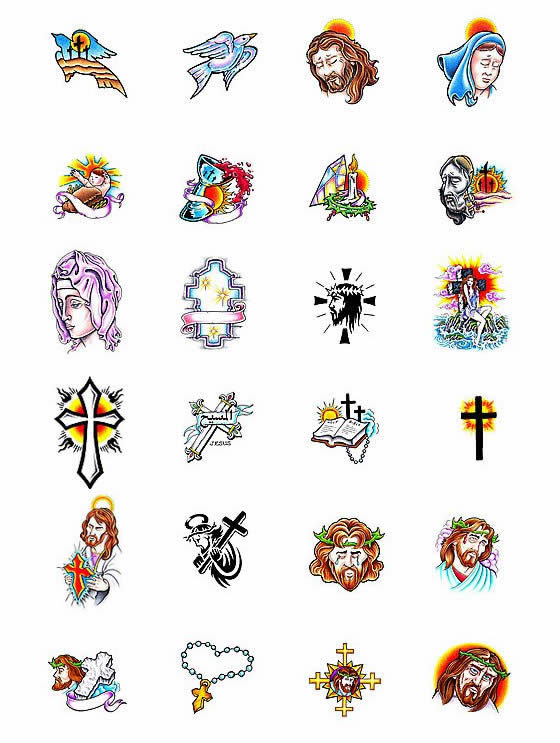 As long as people have been marking and modifying their physical appearance, there has been a strong spiritual element to the practice of body art and body modification. Even before the rise of organized religions, Judaism, Christianity and Islam in the West and Buddhism & Hinduism in the East, with their widely recognized symbols of religious faith and devotion, tattoos often clearly were intended to serve a purpose beyond simple expressions of decoration and identification. Many early tattoos clearly had a cosmic connection and wove early man into the fabric of the larger universe.
As long as people have been marking and modifying their physical appearance, there has been a strong spiritual element to the practice of body art and body modification. Even before the rise of organized religions, Judaism, Christianity and Islam in the West and Buddhism & Hinduism in the East, with their widely recognized symbols of religious faith and devotion, tattoos often clearly were intended to serve a purpose beyond simple expressions of decoration and identification. Many early tattoos clearly had a cosmic connection and wove early man into the fabric of the larger universe.  Early cultures often inscribed themselves with animal images and totems, probably in an effort to evoke the power of the animal spirits, possibly for success in the hunt, but also for protection. Even today, in one of the remotest parts of the planet, the Kayan tribesman in Borneo receives a pair of hand-tapped tattoos on both shoulders to guarantee his safe passage, as a departed soul, across the River of the Dead. These are tattoos with roots back to a time when the meaning was much more than skin deep and beyond simple decoration.
Early cultures often inscribed themselves with animal images and totems, probably in an effort to evoke the power of the animal spirits, possibly for success in the hunt, but also for protection. Even today, in one of the remotest parts of the planet, the Kayan tribesman in Borneo receives a pair of hand-tapped tattoos on both shoulders to guarantee his safe passage, as a departed soul, across the River of the Dead. These are tattoos with roots back to a time when the meaning was much more than skin deep and beyond simple decoration.
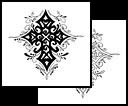 In more modern times, the Crusaders tattooed a small cross on their hand to ensure a Christian burial in the event they were killed in battle in foreign lands. Around the world, believers in different faiths have tattooed symbols of their religion on their bodies to ensure a proper burial. And today, in a tattoo culture where much of the artistry is for decorative purposes only, the resurgence of religious tattoos is once again bringing the faithful into the tattoo studio.
In more modern times, the Crusaders tattooed a small cross on their hand to ensure a Christian burial in the event they were killed in battle in foreign lands. Around the world, believers in different faiths have tattooed symbols of their religion on their bodies to ensure a proper burial. And today, in a tattoo culture where much of the artistry is for decorative purposes only, the resurgence of religious tattoos is once again bringing the faithful into the tattoo studio.
You can credit large numbers of evangelical Christians for helping to make religious tattoos one of the most popular sectors of the current tattoo industry. Approximately 20% of the tattoos inked in North America today are religious in nature, which is to say that the wearer sees their body art as a way to get closer to their concept of God and proclaim their faith.
 The most popular symbols of choice for most Christians are Crosses, Angels, Doves, and Praying Hands. With these images they are looking to more permanently express their individuality, identity and faith. They have put the famous biblical prohibition well behind them (Leviticus 19:28) as their churches adopt modern movements like rock and roll to attract youth to the altar.
The most popular symbols of choice for most Christians are Crosses, Angels, Doves, and Praying Hands. With these images they are looking to more permanently express their individuality, identity and faith. They have put the famous biblical prohibition well behind them (Leviticus 19:28) as their churches adopt modern movements like rock and roll to attract youth to the altar.
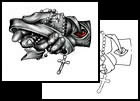 Symbols of Roman Catholicism are also extremely popular among certain segments of the faithful and within Latino culture you will see Rosary Beads, the Madonna, the Crucifixion, the Crown of Thorns and Sacred Hearts prominently featured along with the more standard Crosses and Angels.
Symbols of Roman Catholicism are also extremely popular among certain segments of the faithful and within Latino culture you will see Rosary Beads, the Madonna, the Crucifixion, the Crown of Thorns and Sacred Hearts prominently featured along with the more standard Crosses and Angels.
Historically, and from a cultural-anthropological stand-point, some of the earliest tattoos had a spiritual connection. Animal images were popular with tribesmen because of the desire of the tattoo recipient to become identified with the animal spirit. The ritual involved in getting a tattoo, the very act of submitting to pain, is one way to bring the spirit alive and prompt the discovery of the God within. The spiritual leader of the tribe, the Shaman or the Medicine Man, in particular, needed ornaments to indicate his special relationship with the spirits or gods -- and his control or power over them. Tattoos were part of his arsenal, along with other amulets in the form of shells, horns, antlers, claws and teeth of animals.
The tribe’s dominant symbols were powerful icons representing their belief systems. It has been suggested by philosopher James Hillman that our most potent symbols do not just emanate from the soul, but are actually what the soul is made of. "In the beginning was the word?" Perhaps not. We are beginning to hear the argument that, even before ‘the word’, was the symbol and the myth. But let us save our metaphysical musings for something more tangible but no less astonishing -- the tattoo as talisman or savior.
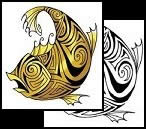 A recurring theme in religious or spiritual tattoos concerns the afterlife. The great mystery of life and existence has fuelled myth, magic and special rites in almost every culture around the world. Amazingly, from the MAORI in New Zealand, to the SIOUX in North Dakota, to the IBAN tribes up the Skrang River in Borneo, the tattoo is nothing less than a passport to the world beyond. You simply could not leave home without it, not if you wanted admittance or any sort of status ‘on the other shore’. The right tattoo could ensure favor with deities, without which the dying person would not be recognized in the land of the spirits. In head-hunter country in Borneo, the tattoo also served as a torch to light the way across the river that ran through the Land of the Dead. Departed souls had to venture up this treacherous river to reach the long-houses of their most heroic ancestors. So arduous was this journey that only the most heavily tattooed tribesman could complete the journey.
A recurring theme in religious or spiritual tattoos concerns the afterlife. The great mystery of life and existence has fuelled myth, magic and special rites in almost every culture around the world. Amazingly, from the MAORI in New Zealand, to the SIOUX in North Dakota, to the IBAN tribes up the Skrang River in Borneo, the tattoo is nothing less than a passport to the world beyond. You simply could not leave home without it, not if you wanted admittance or any sort of status ‘on the other shore’. The right tattoo could ensure favor with deities, without which the dying person would not be recognized in the land of the spirits. In head-hunter country in Borneo, the tattoo also served as a torch to light the way across the river that ran through the Land of the Dead. Departed souls had to venture up this treacherous river to reach the long-houses of their most heroic ancestors. So arduous was this journey that only the most heavily tattooed tribesman could complete the journey.
Likewise, the final destination for the spirit of the SIOUX warrior was known as 'Many Lodges', and his tattoos played a crucial role in the journey. Success was only possible if he had been appropriately marked on the forehead, wrist and possibly on the tip of the chin. Legend has it that an old woman checked the tattoos of all the passing spirits. The un-tattooed would be dropped over a cliff, a most ignoble return to the land of the living, where he would wander aimlessly for eternity.
For many indigenous people around the world, a return to traditional tribal tattooing practices has been a powerful way to re-ignite a cultural renaissance and to reclaim a spiritual link to their past. This fact has no doubt played an important role in the widespread popularity of tribal tattooing today.
Modern Christians seeking historical precedent for their religious tattoos can look back to Anglo-Saxon culture. Tattoos were then so common that the Council of Northumberland (787 AD) passed legislation to restrict the practice. The biblical passage in Leviticus 19:28 notwithstanding, Christian tattoos, escaped the prohibition. A little later, during the tenth, eleventh and twelfth centuries, the Crusaders went into battle with a small cross tattooed on the back of the hand or the arm, which was a virtual lifeline to their eternal salvation. Pilgrims who made a successful pilgrimage to Jerusalem marked the occasion with a tattoo which they could then show the folks back home. The tattoo was the mark of the most faithful.
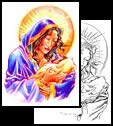 The impact and adoption of Christian symbols and designs would have been hard to restrict, in any case. Think of the Last Supper, portraits of Jesus and Mary, and of course the decorations that proliferate within the primary place of worship - indeed, God's House - the Church itself. What credible rationale could shame a believer into not wearing marks that supported their own true belief - marks and symbols that proliferated because of the patronage of the leaders of the Church? As mentioned earlier, pilgrims to Jerusalem typically tattooed themselves with the date of their pilgrimage, or had more elaborate souvenirs inked to commemorate their journey. The most common designs were St. George on a horse killing a dragon, Christ on the cross, and the Virgin Mary holding the infant Jesus.
The impact and adoption of Christian symbols and designs would have been hard to restrict, in any case. Think of the Last Supper, portraits of Jesus and Mary, and of course the decorations that proliferate within the primary place of worship - indeed, God's House - the Church itself. What credible rationale could shame a believer into not wearing marks that supported their own true belief - marks and symbols that proliferated because of the patronage of the leaders of the Church? As mentioned earlier, pilgrims to Jerusalem typically tattooed themselves with the date of their pilgrimage, or had more elaborate souvenirs inked to commemorate their journey. The most common designs were St. George on a horse killing a dragon, Christ on the cross, and the Virgin Mary holding the infant Jesus.
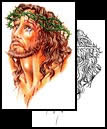 Those who argue the provenance of the allegedly anti-tattoo admonishment in the Old Testament's Leviticus 19:28 - "Do not cut your bodies for the dead, or put marks on yourselves." - usually reason that it was meant to discourage alternate spiritual practices among non-believers. It was the first step in conversion to Christianity to refrain from wearing designs or symbols that were pagan or non-Christian.
Those who argue the provenance of the allegedly anti-tattoo admonishment in the Old Testament's Leviticus 19:28 - "Do not cut your bodies for the dead, or put marks on yourselves." - usually reason that it was meant to discourage alternate spiritual practices among non-believers. It was the first step in conversion to Christianity to refrain from wearing designs or symbols that were pagan or non-Christian.
Choose your religious tattoo design at Tattoo-Art.com.
Find and buy the religious tattoo design that's right for you.
But Christianity is not the only organized modern religion which has had prohibitions against tattoos.
![]()
The KORAN also forbids tattooing, depending on how it is translated. "The guilty are recognized by their marks." The debate rages in Islam, just as it does in Christianity. Meanwhile, the practice of marking the skin was not uncommon amongst Muslims who have journeyed to Mecca or Medina. If tattoos were going to be a problem for a Moslem, it was usually upon admission to paradise. This ceased to be a concern if the wearer was sure he would be purified by fire before entry. "Tattoo? What tattoo?" Bans notwithstanding, tattoos are simply too attractive when it comes to expressing something as fundamental as one’s beliefs.
 For Moslems, their first choices are usually the Crescent with Star - although originally a political symbol, or verses of the Koran, usually in Arabic calligraphy, or the Hand of Fatima. In Islam, which overlaps with Christianity, Angels, Satan, and even Adam and Eve are also meaningful symbols.
For Moslems, their first choices are usually the Crescent with Star - although originally a political symbol, or verses of the Koran, usually in Arabic calligraphy, or the Hand of Fatima. In Islam, which overlaps with Christianity, Angels, Satan, and even Adam and Eve are also meaningful symbols.
![]()
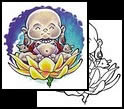 BUDDHA himself was not a fan of iconography, it was after all, just another attachment to leave behind, yet Buddhism is rich with symbols that reinforce its basic tenets -- the Bodhi Tree, the Buddha image, a Dharma Wheel, a Lotus, a Mala, a Mandala, Om, and ‘Om Mane Padme Hum,’ Not a short list at all!. In Thailand, Buddhist monks do double duty as tattooists during an annual March festival. The tattoos are intended to work as amulets warding off injury or bringing strength to the wearer.
BUDDHA himself was not a fan of iconography, it was after all, just another attachment to leave behind, yet Buddhism is rich with symbols that reinforce its basic tenets -- the Bodhi Tree, the Buddha image, a Dharma Wheel, a Lotus, a Mala, a Mandala, Om, and ‘Om Mane Padme Hum,’ Not a short list at all!. In Thailand, Buddhist monks do double duty as tattooists during an annual March festival. The tattoos are intended to work as amulets warding off injury or bringing strength to the wearer.
![]()
 HINDUS of the highest caste, the Brahmins, have a long history of tattooing in a culture that has no special prohibition against tattooing. They traditionally received a series of lines or circles on the forehead, cheeks, or chest to proclaim their servitude to God. It also didn’t hurt to remind others of their membership in India’s highest caste. Bengal Hindus applied tattoos for reasons similar to those in (what we call) more primitive religions -- so that after death he would be recognized by relatives in the world of the spirits. On a more questionable note, some Hindu temple girls received sacred symbols on the shoulder and breast to guarantee the salvation of their souls.
HINDUS of the highest caste, the Brahmins, have a long history of tattooing in a culture that has no special prohibition against tattooing. They traditionally received a series of lines or circles on the forehead, cheeks, or chest to proclaim their servitude to God. It also didn’t hurt to remind others of their membership in India’s highest caste. Bengal Hindus applied tattoos for reasons similar to those in (what we call) more primitive religions -- so that after death he would be recognized by relatives in the world of the spirits. On a more questionable note, some Hindu temple girls received sacred symbols on the shoulder and breast to guarantee the salvation of their souls.
![]()
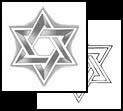 Many JEWS still take Leviticus seriously, while others see the prohibition aimed at indelibly marking yourself with symbols associated with some other belief system. In which case, any religion-neutral tattoo would be fair game, along with any of the striking Jewish symbols themselves. Without doubt, many Jewish people get tattoos, and their favorites have long been the Star of David, the menorah, the name of Yahweh, and the nine-pointed star called the enneagram.
Many JEWS still take Leviticus seriously, while others see the prohibition aimed at indelibly marking yourself with symbols associated with some other belief system. In which case, any religion-neutral tattoo would be fair game, along with any of the striking Jewish symbols themselves. Without doubt, many Jewish people get tattoos, and their favorites have long been the Star of David, the menorah, the name of Yahweh, and the nine-pointed star called the enneagram.
![]()
To the early COPTIC CHRISTIANS in Egypt, tattoos were part of their religious life. Pilgrimages were hugely important, and the only way to prove you had been to the Holy Land, for instance, was to return with a tattoo of the kind that only a Coptic priest was permitted to apply. The designs were applied from woodblocks in order to speed up the process, the most common tattoo being a small cross on the inside of the wrist. Operating from stall outside the walls of Jerusalem, the priests’ work was rough, but you might say it was the thought that counted. Only with the tattoo would folks back home believe you had actually prayed at the holy shrines.
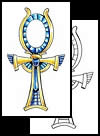 Egyptian Copts adopted the "ankh" as their version of the cross. (Did you know that Egypt was the first country to adopt Christianity as its official religion?) While tattooing in ancient Egypt was not commonplace, the ankh certainly has found a following among modern tattoo recipients. It’s part of the Egyptian hieroglyphics constellation, and forms part of the words "happiness" and "health". Most of the ancient Egyptian gods and goddesses wore the ankh as an amulet, since it symbolized life and immortality. Some saw it, naturally, as the ‘key to life’, including the afterlife. Egyptians were buried with the ankh to ensure their ‘life to come’, and in the hope that it would unlock the gates to heaven.
Egyptian Copts adopted the "ankh" as their version of the cross. (Did you know that Egypt was the first country to adopt Christianity as its official religion?) While tattooing in ancient Egypt was not commonplace, the ankh certainly has found a following among modern tattoo recipients. It’s part of the Egyptian hieroglyphics constellation, and forms part of the words "happiness" and "health". Most of the ancient Egyptian gods and goddesses wore the ankh as an amulet, since it symbolized life and immortality. Some saw it, naturally, as the ‘key to life’, including the afterlife. Egyptians were buried with the ankh to ensure their ‘life to come’, and in the hope that it would unlock the gates to heaven.
![]()
And speaking of heavens and constellations, it should come as no surprise that for many people who want to express a personal feeling of spirituality while not tying themselves to any recognized religion, tattoo designs and symbols that could be best described as "Cosmic" are exceedingly popular. Stars, suns, moons and other cosmic symbols are among the top ten most popular tattoo designs. Tattoo designs that speak to the vastness of the Universe are also very popular, such as symbols of Infinity, Eternity and Ouroboros.
For modern Wiccans, Witches and New Age Pagans, they too have a rich tradition of tattoo symbols and designs to draw from, including the rich Celtic and Norse symbolic heritage.
So if you wish to express your faith to the world, tattoos have a long and storied history and an immense library of images with which you can share with others your religious and spiritual beliefs.
Source : http://www.vanishingtattoo.com/tattoos_designs_symbols_religious.htm
